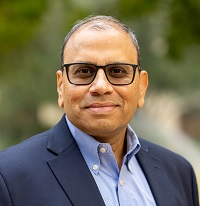A holistic viewpoint on sustainability – Transcript

I recently spoke with Eryn Devola and Rahul Garg about the impact of sustainability on the industrial machinery industry in part 3 of our podcast series. Check out the podcast here, or keep reading for the full transcript.
Read the transcript

Head of Sustainability at Siemens Digital Industries Software
Blake: Hello and welcome to another episode of our Sustainability Podcast series. I’m Blake Snodgrass, one of the writers for the Thought Leadership team at Siemens. Our last episode in this series explored sustainability and how companies are exploring it and the challenges that stand in their way. They’re using a digitalization strategy to help achieve their objectives.
We will continue the sustainability theme, focusing on industrial machinery. Joining us again is our resident expert Eryn Devola, head of Sustainability at Siemens Digital Industries Software, and we also welcome Rahul Garg, VP Industrial Machinery and SMB Business Program at Siemens Digital Industries Software.

VP Industrial Machinery and SMB Business Program at Siemens Digital Industries Software
Eryn and Rahul will discuss the key trends driving the need for a sustainable business strategy in the industrial machinery industry. So, for our listeners that may have missed the last podcast, can each of you, Eryn and Raul, provide us with a brief bio of your experience and background?
Let’s start with you Eryn.
Eryn: Sure, I’d love to share. I’m a mechanical engineer by training and have spent the last 20 plus years working in the industry. Those first ten years were in white goods or home appliances.
I had a variety of roles in quality, reliability, test engineering and came to Siemens about 12 years ago. Since I’ve been with Siemens, I’ve had the opportunity to work in many different areas in our portfolio, from medium voltage drives for heavy machinery industries to electronics for mobility. And, to now my current role now in sustainability.
So, I really have had an opportunity to see a lot of businesses that look a lot like our customers business in moving forward. And with my current role, I get the opportunity to talk to those customers about the role that sustainability plays and the importance of it as an outcome coming forward.
Blake: Excellent. How about you Rahul?
Rahul: I’m an electrical computer engineer by background and I’ve been involved with the design and development of software and other such activities for the last 20 to 30 plus years, led three startups, and then I’ve been part of Siemens for the last 20 plus years.
The whole topic of sustainability is certainly very exciting as it draws some new thinking that has not been part of core analysis and core design thinking for a long time.
So, it’s great to be here.
Blake: Great, so let’s kick this podcast off.
Rahul, could you provide our audience with some of the key trends that you see that are driving the need for a sustainable business strategy in the industrial machinery industry?
Rahul: Yeah, to me there are three to four key issues that are driving sustainability and the need for change.
- The first one is the commitments and the reporting and compliance that’s being driven by the regulatory bodies, government bodies, and others.
- The second one is around capital flow. Money is being invested in driving smarter sustainable factories, which is what industrial machinery companies are doing eventually.
- Third is the social aspect of resource scarcity at the end of the day. We all have some obligations in terms of trying to manage a better manager. The resources we have at our disposable in this world and even some of the challenges that we are creating with the way we are using our resources, so, that’s an important challenge and issue as well.
- Lastly, is customers. Customers are demanding that equipment providers are make their equipment more sustainable.
Those are the big four drivers of needing industrial machinery companies to change the way and look at sustainability as a very as a very important imperative in their go forward business strategy.
Blake: Right.
Eryn: One of the things that I would add to that is as I look at some of those trends through the lens of industrial machinery, you see how electrification and the need for electrification is driving the need for efficiency. Many of those processes require a lot of energy density that is available in a fossil fuel, not the same way it’s available in electricity. I’m trying to drive down the energy used to manufacture and convert materials needed to be evaluated and optimized at every corner.
Rahul: I think that’s a great point, Eryn. Because at the end of the day, not only is there the issue of emissions from energy consumption from fossil fuels, there’s also the cost of energy, as energy is coming down at all. If anything, it just continues to stay there or go up. So, it becomes another big driver for trying to figure out how to optimize that cost as well.
Blake: Those are all great points. So, can either of you provide us with a holistic view of digitalization and sustainability?
Eryn: You know from my viewpoint, digitalization drives sustainability, it’s the how to the what. So, sustainability is an outcome that requires a lot of planning and a lot of tools to make it happen. Digitalization is really one of the key levers to do that. It gives you the opportunity to look at the entire product lifecycle, taking data from many different phases and being able to visualize what gives you the ability to try several different things as you run through simulation tools.
Being able to try out many different scenarios, and pulling things together within the context of digitalization, allows people to exchange data without achieving that one entity. We need to really achieve it by looking outside our own gate.
By looking at everyone in our value chain and ecosystem, we see a lot of success with sustainability coming from people working together, exchanging data, sharing information, and defending standards, even across competitors, to move the entire area forward.
So I think that those are a couple of the ways that digitalization really helps drive sustainability.
Rahul: Yes, I think those are some great thoughts as to what’s happening today and one of the things that comes to my mind here is that digitalization was primarily viewed as helping a company become a digital enterprise to become more adaptable, more agile, more flexible and overall improve their ability to deliver their product.
So, with the right time, quality, and cost. So, I think leveraging digitalization for the things you mentioned: energy efficiency, decarbonization circularity, and resource efficiency is where it really brings it all together in a very comprehensive way for many of our customers.
Eryn: It’s really an evolution, right? So, you started out with these tools with basic or first level outcomes. We talked about this and the previous podcast we did with Dale, which is that these different dimensions make the work of designing and producing equipment significantly more difficult.
However, the good news is that digitalization gives you those tools to make it palatable and executable along the way. So, as we make it more complicated with more outcomes, we also are providing digital tools and enablement to make it manageable moving forward.
Rahul: That’s a very good point. Yes, it’s going to get harder to manage that or to build in that complex environment. So, digitalization provides you with those tools to make your job easier.
Eryn: And I think it also gives you that view to be able to see the whole value chain where all the entities in that chain work together to move it forward to find those pain points much more universally. You’re holistically working together to attack them.
And I think that’s one of the beautiful things that having the safe, secure exchange of data allows people to do. You can visualize that data not just across my entity, but across the entire lifecycle of a product, across the production line or production facility. That is really the big data implications here for industry and how those must feed not only traditional outcomes but also the sustainability outcomes.
Rahul: Yes, and as we continue to talk about this topic, it’s the heart of the conversation. When you are trying to look at how to optimize your design process using digitalization tools, you look at suppliers, the cost of the part that you’re buying from a supplier, and the carbon footprint that the part may have or the carbon footprint that the partner of the supplier may have in delivering it to your factory or location.
So, all can be evaluated right up front by having access to digitalization tools. And it makes it convenient to do that analysis and easier to bring it all together.
Eryn: And you have so much more you’re able to do in the realization phase when you’re planning the design of the product and planning the machinery that will manufacture it. This is when you can make those decisions about how energy efficient the equipment is and how long that product is going to last. When you have that information to make those good decisions up front, we talk a lot about brownfield factories. Still, we also have brownfield designs or designs already out there, and we are trying to make them more environmentally friendly. This process is more complex than starting from the beginning with the information you need to make them environmentally friendly from the start.
Rahul: That’s a good point. How do you make the brown into green, right?
Eryn: Right.
Rahul: Good.
Blake: That’s great. Let’s get a little bit more granular here. Could you provide us with some of the main elements that show how sustainability relates to the industrial machinery industry?
Rahul: Yeah, I think we better ask how digitalization can be leveraged for sustainability too. So, to me there are three key elements which come into play.
The first one is the upfront design for sustainability itself. So, when you’re doing your design now, you’re no longer just trying to design your machine for the highest possible throughput or the highest possible quality, you also design it for the highest possible energy efficiency and circularity to make it easy for you to remanufacture or refurbish, thus extending the life of the machine. So, all these design concepts have become very important.
The second piece is sustainability in the manufacturing of the machines. I think we kind of touched upon that example where you must evaluate how your suppliers is going to be providing you parts into your own machine. So, how sustainable are they in their efforts in making their parts?
And then the biggest impact that I see is the sustainability impact from operating machines end of the day when you’re running a machine. This is when the highest impact of energy consumption is happening. That’s when the carbon footprint is getting impacted, and the life of a machine could be as little as six months to as much as 60 years. Also, in many cases, what’s the energy impact? What’s the consumables impact? What kind of recyclability does it have in terms of even waste and water that’s getting recycled from the machine?
So, a lot of those impacts from use and the operation of the machine are big factors that are important from an industrial machine perspective that need to be factored in as part of the overall operation of an industrial machinery company.
Eryn: You hit on something there, especially concerning carbon, or the carbon footprint of a product, as we tend to think of it in these scopes: scope one and scope 3 upstream, which is your supply chain – and scope three downstream, which is the use-phase and what we think about industrial machinery that scopes three downstream or use-phase is the most significant impact that you have.
So, all those decisions regarding how to make energy efficient have the most extraordinary power on the overall environmental footprint of that piece of machinery.
And all of those decisions regarding how to make energy efficient, have the greatest power on the overall environmental footprint of that piece of machinery.
The other two things that you touched on is that the longer the life we can design for, those materials are used for longer, which is important and the most significant factor that drives what we like to call circularity or keeping materials and resources in the product as long as possible.
Also, we want them to be able to recycle when they’re complete, but extending their life driving remanufactured, refurbished repair and then design for disassembly and retrofit.
In turn, we get new technology that could make it more energy efficient, and then we can upgrade those products along the way. These are some of the coming trends around sustainability that will impact industrial machinery.
Rahul: Yeah, good points.
Blake: We are out of time for now, but I want to thank both Eryn Devola and Rahul Garg for their contribution to this episode. Please stay tuned for more podcasts on this exciting topic. Bye for now.
Siemens Digital Industries Software helps organizations of all sizes digitally transform using software, hardware and services from the Siemens Xcelerator business platform. Siemens’ software and the comprehensive digital twin enable companies to optimize their design, engineering and manufacturing processes to turn today’s ideas into the sustainable products of the future. From chips to entire systems, from product to process, across all industries. Siemens Digital Industries Software – Accelerating transformation.
Comments
Leave a Reply
You must be logged in to post a comment.



In an ever-changing world, where the consequences of our actions reverberate across the globe, it is crucial to adopt a holistic viewpoint on sustainability. Such a perspective encompasses not only environmental concerns but also social and economic aspects, recognizing the intricate interconnections between them.